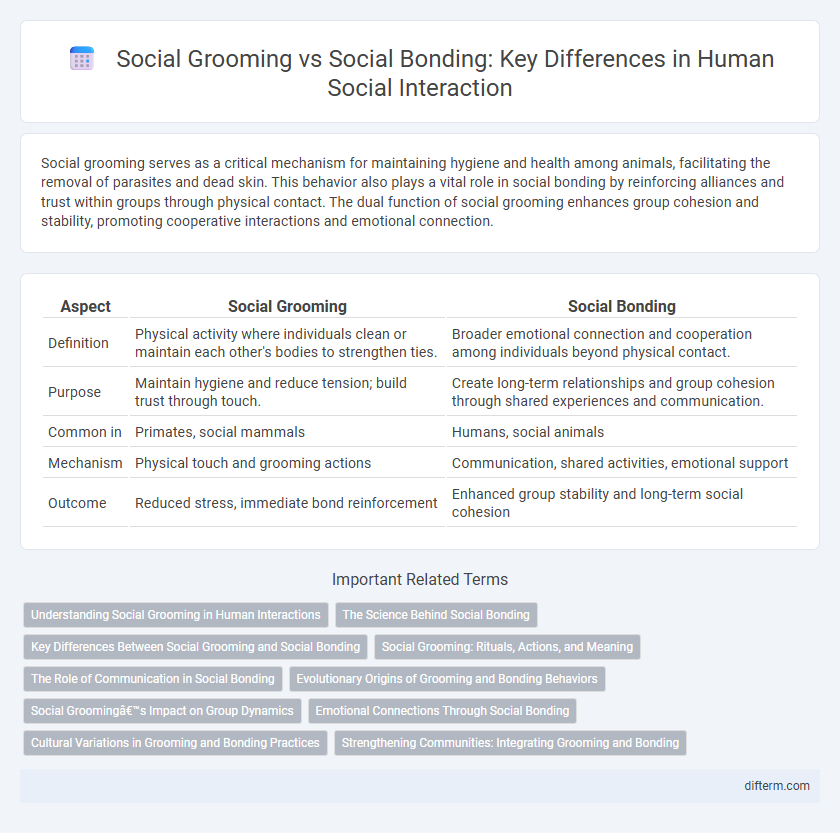Social grooming serves as a critical mechanism for maintaining hygiene and health among animals, facilitating the removal of parasites and dead skin. This behavior also plays a vital role in social bonding by reinforcing alliances and trust within groups through physical contact. The dual function of social grooming enhances group cohesion and stability, promoting cooperative interactions and emotional connection.
Table of Comparison
| Aspect | Social Grooming | Social Bonding |
|---|---|---|
| Definition | Physical activity where individuals clean or maintain each other's bodies to strengthen ties. | Broader emotional connection and cooperation among individuals beyond physical contact. |
| Purpose | Maintain hygiene and reduce tension; build trust through touch. | Create long-term relationships and group cohesion through shared experiences and communication. |
| Common in | Primates, social mammals | Humans, social animals |
| Mechanism | Physical touch and grooming actions | Communication, shared activities, emotional support |
| Outcome | Reduced stress, immediate bond reinforcement | Enhanced group stability and long-term social cohesion |
Understanding Social Grooming in Human Interactions
Social grooming in human interactions involves behaviors such as touching, complimenting, and active listening, which reinforce social bonds and trust within groups. These actions serve as non-verbal communication tools that strengthen connections and promote cooperation among individuals. Unlike broader social bonding, social grooming targets specific relationships through intentional, repetitive gestures that enhance emotional closeness.
The Science Behind Social Bonding
Social bonding is a complex neurobiological process involving the release of oxytocin and endorphins, which strengthen interpersonal connections and promote group cohesion. Social grooming, observed in primates and humans, serves as a behavioral mechanism to reinforce these bonds by reducing stress and enhancing trust through tactile interaction. Research highlights how regular social grooming supports emotional well-being and stabilizes social networks by fostering cooperative behaviors and reciprocity.
Key Differences Between Social Grooming and Social Bonding
Social grooming refers to the physical act of cleaning or maintaining another individual's body, primarily observed in primates, serving as a tool for establishing trust and reducing tension within groups. Social bonding encompasses a broader range of interactions, including emotional support, shared activities, and communication, which strengthen relational ties beyond physical contact. The key differences lie in social grooming's tangible, reciprocal nature versus social bonding's multifaceted, psychological connection that sustains long-term group cohesion.
Social Grooming: Rituals, Actions, and Meaning
Social grooming encompasses a range of ritualistic behaviors such as mutual grooming, cleaning, and physical touch that strengthen social bonds and establish group hierarchy. These actions serve as non-verbal communication tools, fostering trust and cooperation within primate groups, including humans. The meaning of social grooming extends beyond hygiene, playing a crucial role in emotional well-being and social cohesion by reinforcing alliances and reducing tensions.
The Role of Communication in Social Bonding
Communication plays a crucial role in social bonding by facilitating emotional exchanges and strengthening interpersonal connections through both verbal and non-verbal cues. Unlike social grooming, which primarily involves tactile interactions to build alliances, communication enables individuals to share information, express empathy, and negotiate social hierarchies within complex social groups. Effective communication enhances group cohesion, trust, and cooperation, serving as the foundation for enduring social bonds across human and animal societies.
Evolutionary Origins of Grooming and Bonding Behaviors
Social grooming and social bonding behaviors have evolutionary origins rooted in the survival and cohesion of primate groups. Grooming serves not only hygienic purposes by removing parasites but also reinforces alliances and trust, crucial for group stability and cooperative behavior. These behaviors are fundamental in the development of complex social structures, enabling enhanced communication and collective defense mechanisms.
Social Grooming’s Impact on Group Dynamics
Social grooming plays a crucial role in reinforcing social bonds and hierarchical structures within groups, directly influencing group cohesion and cooperation. By facilitating trust and reducing stress among members, social grooming enhances communication and collective problem-solving abilities. This behavior fosters stability and resilience in social networks, ultimately improving group survival and success.
Emotional Connections Through Social Bonding
Social bonding strengthens emotional connections by fostering trust and empathy through shared experiences and mutual support. Unlike social grooming, which primarily maintains group cohesion through physical interactions, social bonding creates deeper, long-lasting relationships that enhance psychological well-being. Emotional connections built via social bonding significantly impact mental health, reducing stress and promoting resilience.
Cultural Variations in Grooming and Bonding Practices
Cultural variations in social grooming and bonding practices reveal diverse methods of reinforcing community ties, such as gift-giving and shared meals in some societies versus physical touch and verbal affirmations in others. These practices serve distinct functions in maintaining social cohesion, with grooming often emphasizing hierarchical relationships and bonding focusing on emotional closeness. Understanding these variations enhances insights into how different cultures cultivate trust, cooperation, and group identity.
Strengthening Communities: Integrating Grooming and Bonding
Social grooming serves as a crucial mechanism for reinforcing trust and cooperation within communities by fostering personal connections through tactile interactions. Social bonding extends beyond grooming by building emotional resilience and collective identity among group members, enhancing overall community cohesion. Integrating grooming practices with broader social bonding activities strategically strengthens networks and promotes sustained collaborative environments.
social grooming vs social bonding Infographic

 difterm.com
difterm.com